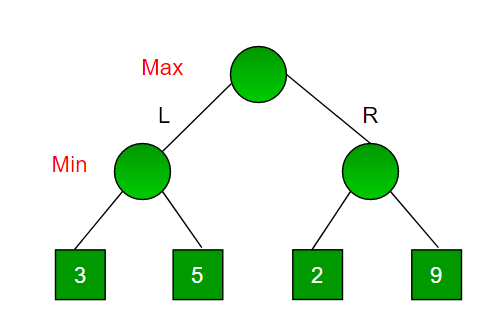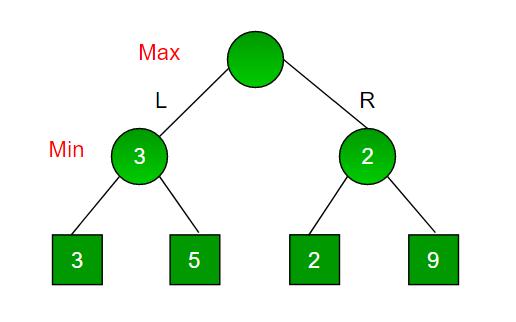Minimax Algorithm in Game Theory | Set 1 (Introduction)
Last Updated :
13 Jun, 2022
Minimax is a kind of backtracking algorithm that is used in decision making and game theory to find the optimal move for a player, assuming that your opponent also plays optimally. It is widely used in two player turn-based games such as Tic-Tac-Toe, Backgammon, Mancala, Chess, etc.
In Minimax the two players are called maximizer and minimizer. The maximizer tries to get the highest score possible while the minimizer tries to do the opposite and get the lowest score possible.
Every board state has a value associated with it. In a given state if the maximizer has upper hand then, the score of the board will tend to be some positive value. If the minimizer has the upper hand in that board state then it will tend to be some negative value. The values of the board are calculated by some heuristics which are unique for every type of game.
Example:
Consider a game which has 4 final states and paths to reach final state are from root to 4 leaves of a perfect binary tree as shown below. Assume you are the maximizing player and you get the first chance to move, i.e., you are at the root and your opponent at next level. Which move you would make as a maximizing player considering that your opponent also plays optimally?

Since this is a backtracking based algorithm, it tries all possible moves, then backtracks and makes a decision.
- Maximizer goes LEFT: It is now the minimizers turn. The minimizer now has a choice between 3 and 5. Being the minimizer it will definitely choose the least among both, that is 3
- Maximizer goes RIGHT: It is now the minimizers turn. The minimizer now has a choice between 2 and 9. He will choose 2 as it is the least among the two values.
Being the maximizer you would choose the larger value that is 3. Hence the optimal move for the maximizer is to go LEFT and the optimal value is 3.
Now the game tree looks like below :

The above tree shows two possible scores when maximizer makes left and right moves.
Note: Even though there is a value of 9 on the right subtree, the minimizer will never pick that. We must always assume that our opponent plays optimally.
Below is the implementation for the same.
C++
#include<bits/stdc++.h>
using namespace std;
int minimax(int depth, int nodeIndex, bool isMax,
int scores[], int h)
{
if (depth == h)
return scores[nodeIndex];
if (isMax)
return max(minimax(depth+1, nodeIndex*2, false, scores, h),
minimax(depth+1, nodeIndex*2 + 1, false, scores, h));
else
return min(minimax(depth+1, nodeIndex*2, true, scores, h),
minimax(depth+1, nodeIndex*2 + 1, true, scores, h));
}
int log2(int n)
{
return (n==1)? 0 : 1 + log2(n/2);
}
int main()
{
int scores[] = {3, 5, 2, 9, 12, 5, 23, 23};
int n = sizeof(scores)/sizeof(scores[0]);
int h = log2(n);
int res = minimax(0, 0, true, scores, h);
cout << "The optimal value is : " << res << endl;
return 0;
}
|
Java
import java.io.*;
class GFG {
static int minimax(int depth, int nodeIndex, boolean isMax,
int scores[], int h)
{
if (depth == h)
return scores[nodeIndex];
if (isMax)
return Math.max(minimax(depth+1, nodeIndex*2, false, scores, h),
minimax(depth+1, nodeIndex*2 + 1, false, scores, h));
else
return Math.min(minimax(depth+1, nodeIndex*2, true, scores, h),
minimax(depth+1, nodeIndex*2 + 1, true, scores, h));
}
static int log2(int n)
{
return (n==1)? 0 : 1 + log2(n/2);
}
public static void main (String[] args) {
int scores[] = {3, 5, 2, 9, 12, 5, 23, 23};
int n = scores.length;
int h = log2(n);
int res = minimax(0, 0, true, scores, h);
System.out.println( "The optimal value is : " +res);
}
}
|
C#
using System;
public class GFG
{
static int minimax(int depth, int nodeIndex, bool isMax,
int []scores, int h)
{
if (depth == h)
return scores[nodeIndex];
if (isMax)
return Math.Max(minimax(depth+1, nodeIndex*2, false, scores, h),
minimax(depth+1, nodeIndex*2 + 1, false, scores, h));
else
return Math.Min(minimax(depth+1, nodeIndex*2, true, scores, h),
minimax(depth+1, nodeIndex*2 + 1, true, scores, h));
}
static int log2(int n)
{
return (n==1)? 0 : 1 + log2(n/2);
}
static public void Main ()
{
int []scores = {3, 5, 2, 9, 12, 5, 23, 23};
int n = scores.Length;
int h = log2(n);
int res = minimax(0, 0, true, scores, h);
Console.WriteLine( "The optimal value is : " +res);
}
}
|
Python3
import math
def minimax (curDepth, nodeIndex,
maxTurn, scores,
targetDepth):
if (curDepth == targetDepth):
return scores[nodeIndex]
if (maxTurn):
return max(minimax(curDepth + 1, nodeIndex * 2,
False, scores, targetDepth),
minimax(curDepth + 1, nodeIndex * 2 + 1,
False, scores, targetDepth))
else:
return min(minimax(curDepth + 1, nodeIndex * 2,
True, scores, targetDepth),
minimax(curDepth + 1, nodeIndex * 2 + 1,
True, scores, targetDepth))
scores = [3, 5, 2, 9, 12, 5, 23, 23]
treeDepth = math.log(len(scores), 2)
print("The optimal value is : ", end = "")
print(minimax(0, 0, True, scores, treeDepth))
|
Javascript
<script>
function minimax(depth, nodeIndex, isMax,
scores, h)
{
if (depth == h)
return scores[nodeIndex];
if (isMax)
return Math.max(minimax(depth+1, nodeIndex*2, false, scores, h),
minimax(depth+1, nodeIndex*2 + 1, false, scores, h));
else
return Math.min(minimax(depth+1, nodeIndex*2, true, scores, h),
minimax(depth+1, nodeIndex*2 + 1, true, scores, h));
}
function log2(n)
{
return (n==1)? 0 : 1 + log2(n/2);
}
let scores = [3, 5, 2, 9, 12, 5, 23, 23];
let n = scores.length;
let h = log2(n);
let res = minimax(0, 0, true, scores, h);
document.write( "The optimal value is : " +res);
</script>
|
Output:
The optimal value is: 12
Time complexity : O(b^d) b is the branching factor and d is count of depth or ply of graph or tree.
Space Complexity : O(bd) where b is branching factor into d is maximum depth of tree similar to DFS.
The idea of this article is to introduce Minimax with a simple example.
- In the above example, there are only two choices for a player. In general, there can be more choices. In that case, we need to recur for all possible moves and find the maximum/minimum. For example, in Tic-Tac-Toe, the first player can make 9 possible moves.
- In the above example, the scores (leaves of Game Tree) are given to us. For a typical game, we need to derive these values
We will soon be covering Tic Tac Toe with Minimax algorithm.
This article is contributed by Akshay L. Aradhya.
Share your thoughts in the comments
Please Login to comment...